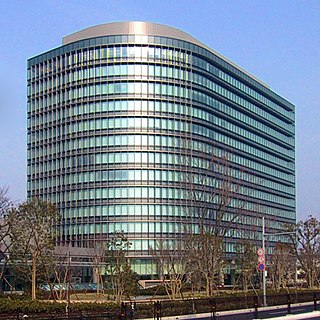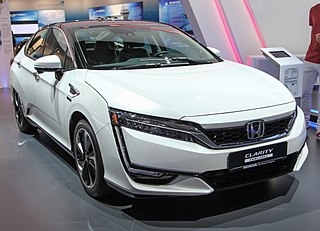
Toyota Motor Corporation is a Japanese multinational automotive manufacturer headquartered in Toyota, Aichi, Japan. In 2017, Toyota's corporate structure consisted of 364,445 employees worldwide and, as of December 2019, was the tenth-largest company in the world by revenue. Toyota is the second largest automobile manufacturer in the world, behind Volkswagen, based on 2018 unit sales. Toyota was the world's first automobile manufacturer to produce more than 10 million vehicles per year, which it has done since 2012, when it also reported the production of its 200-millionth vehicle. As of July 2014, Toyota was the largest listed company in Japan by market capitalization and by revenue.

Traffic on roads consists of road users including pedestrians, ridden or herded animals, vehicles, streetcars, buses and other conveyances, either singly or together, while using the public way for purposes of travel. Traffic laws are the laws which govern traffic and regulate vehicles, while rules of the road are both the laws and the informal rules that may have developed over time to facilitate the orderly and timely flow of traffic.

A hybrid vehicle uses two or more distinct types of power, such as internal combustion engine to drive an electric generator that powers an electric motor, e.g. in diesel-electric trains using diesel engines to drive an electric generator that powers an electric motor, and submarines that use diesels when surfaced and batteries when submerged. Other means to store energy include pressurized fluid in hydraulic hybrids.

Traffic lights, also known as traffic signals, traffic lamps, traffic semaphore, signal lights, stop lights, redlights, robots, and traffic control signals in technical parlance, are signalling devices positioned at road intersections, pedestrian crossings, and other locations to control flows of traffic.

A vehicle registration plate, also known as a number plate, license plate, or licence plate, is a metal or plastic plate attached to a motor vehicle or trailer for official identification purposes. All countries require registration plates for road vehicles such as cars, trucks, and motorcycles. Whether they are required for other vehicles, such as bicycles, boats, or tractors, may vary by jurisdiction. The registration identifier is a numeric or alphanumeric ID that uniquely identifies the vehicle or vehicle owner within the issuing region's vehicle register. In some countries, the identifier is unique within the entire country, while in others it is unique within a state or province. Whether the identifier is associated with a vehicle or a person also varies by issuing agency. There are also electronic license plates.

The Toyota Prius is a full hybrid electric automobile developed and manufactured by Toyota since 1997. Initially offered as a 4-door sedan, it has been produced only as a 4-door liftback since 2003.

The Land Rover Defender is a British four-wheel drive off-road vehicle developed in the 1980s from the original Land Rover series which was launched at the Amsterdam Motor Show in April 1948.
Vehicle size classes are series of ratings assigned to different segments of automotive vehicles for the purposes of vehicle emissions control and fuel economy calculation. Various methods are used to classify vehicles; in North America, passenger vehicles are classified by total interior capacity while trucks are classified by gross vehicle weight rating (GVWR). Vehicle segments in the European Union use linear measurements to describe size. Asian vehicle classifications are a combination of dimensions and engine displacement.

An auto show, also known as a motor show or car show, is a public exhibition of current automobile models, debuts, concept cars, or out-of-production classics. It is attended by automotive industry representatives, dealers, auto journalists and car enthusiasts. Most auto shows occur once or twice a year. They are important to car manufacturers and local dealers as a public relations exercise, as they advertise new products and promote auto brands. The five most prestigious auto shows, sometimes called the "Big Five", are generally considered to be held in Frankfurt, Geneva, Detroit, Paris and Tokyo.

A green vehicle, or clean vehicle, or eco-friendly vehicle or environmentally friendly vehicle is a road motor vehicle that produces less harmful impacts to the environment than comparable conventional internal combustion engine vehicles running on gasoline or diesel, or one that uses certain alternative fuels. Presently, in some countries the term is used for any vehicle complying or surpassing the more stringent European emission standards, or California's zero-emissions vehicle standards, or the low-carbon fuel standards enacted in several countries.

The M3 Scout Car was an American-produced armored car. The original M3 Scout Car was produced in limited numbers, while the improved M3A1 Scout Car saw wide service during World War II and after.

The Honda Clarity is a nameplate used by Honda on alternative fuel vehicles. It was initially used only on hydrogen fuel-cell electric vehicles such as the 2008 Honda FCX Clarity, but in 2017 the nameplate was expanded to include the battery-electric Honda Clarity Electric and the plug-in hybrid electric Honda Clarity Plug-in Hybrid, in addition to the next generation Honda Clarity Fuel Cell.

Emergency vehicle lighting is one or more visual warning lights fitted to a vehicle for use when the driver wishes to convey to other road users the urgency of their journey, to provide additional warning of a hazard when stationary, or in the case of law enforcement as a means of signalling another driver to stop for interaction with an officer. These lights may be dedicated emergency lights, such as a beacon or a light bar, or may be modified stock lighting, such as a wig-wag or hide-away light, and are additional to any standard lighting on the car such as hazard lights. Often, they are used along with a siren in order to increase their effectiveness. In many jurisdictions, the use of these lights may afford the user specific legal powers, and may place requirements on other road users to behave differently, such as compelling them to pull to the side of the road and yield right of way so the emergency vehicle may proceed through unimpeded.
Bus priority or transit signal priority (TSP) is a name for various techniques to improve service and reduce delay for mass transit vehicles at intersections controlled by traffic signals. TSP techniques are most commonly associated with buses, but can also be used along tram/streetcar or light rail lines, especially those that mix with or conflict with general vehicular traffic.

A hybrid electric vehicle (HEV) is a type of hybrid vehicle that combines a conventional internal combustion engine (ICE) system with an electric propulsion system. The presence of the electric powertrain is intended to achieve either better fuel economy than a conventional vehicle or better performance. There is a variety of HEV types, and the degree to which each functions as an electric vehicle (EV) also varies. The most common form of HEV is the hybrid electric car, although hybrid electric trucks and buses also exist.

The Chevrolet Volt is a plug-in hybrid car manufactured by General Motors, also marketed in rebadged variants as the Holden Volt in Australia and New Zealand, Buick Velite 5 in China, and with a different fascia as the Vauxhall Ampera in the United Kingdom and as the Opel Ampera in the remainder of Europe. Volt production ended in February 2019.

A battery electric vehicle (BEV), pure electric vehicle, only-electric vehicle or all-electric vehicle is a type of electric vehicle (EV) that uses chemical energy stored in rechargeable battery packs. BEVs use electric motors and motor controllers instead of internal combustion engines (ICEs) for propulsion. They derive all power from battery packs and thus have no internal combustion engine, fuel cell, or fuel tank. BEVs include – but are not limited to – motorcycles, bicycles, scooters, skateboards, railcars, watercraft, forklifts, buses, trucks, and cars.

The Nissan Leaf, stylised by manufacturer Nissan as LEAF, is a compact five-door hatchback battery electric vehicle, introduced in Japan and the United States in December 2010, and now in its second generation. Its range on a full charge is 243 km.
Green Vehicles Inc. was a manufacturer of electric cars that operated in California from 2008 to 2011. Their best-known product was the Triac, a three-wheeled car that never entered production.
GreenTech Automotive (GTA) is a U.S.- based automotive manufacturer dedicated to developing and producing 100% electric vehicles. It is a subsidiary of WM Industries Corp.















